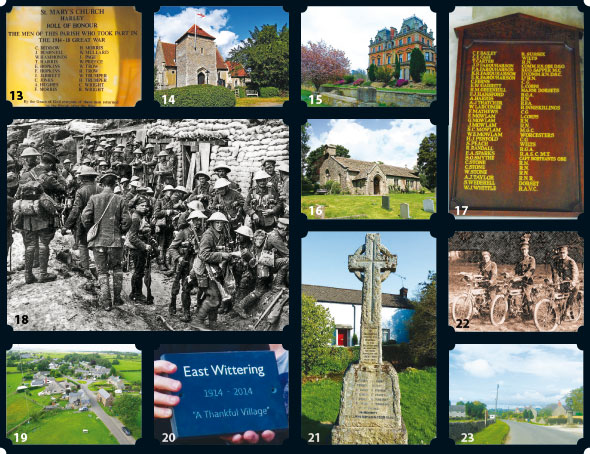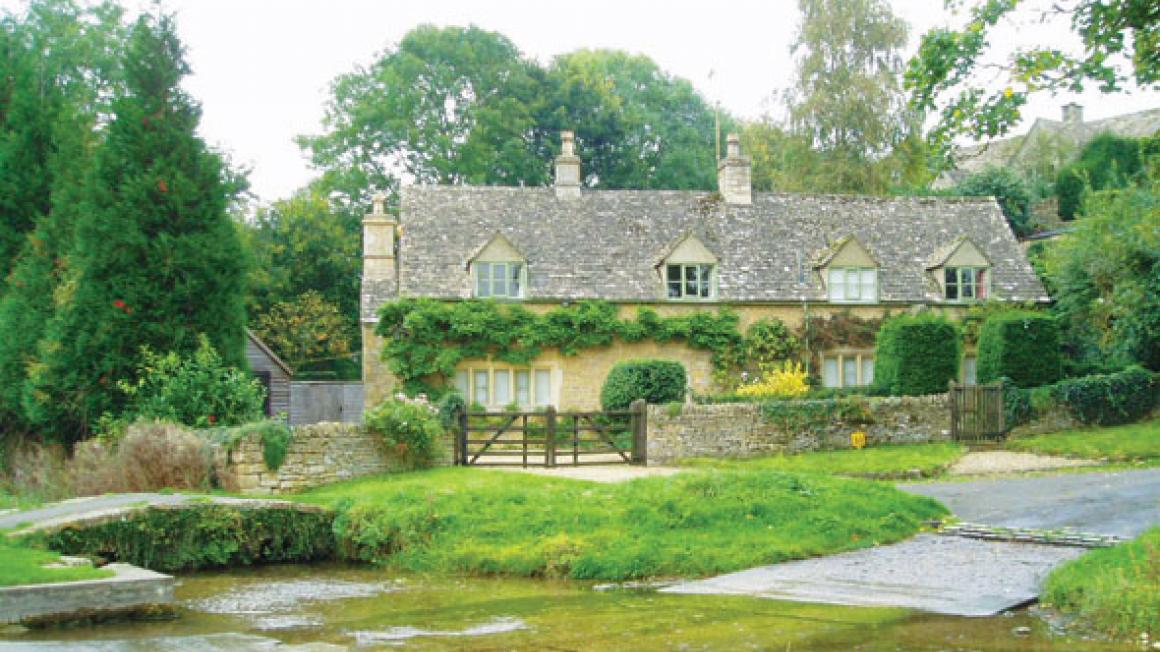REASONS to be THANKFUL
Inside, there is the plaque, a discreet memento not to the men who died in the First World War but to those who came back, for this is one of England’s few ‘Thankful Villages’. The phrase was first coined in the 1930s by the writer Arthur Mee, after discovering 32 villages that had sent men off to the Front in 1914 and miraculously saw them all return – a rare occurrence amid the carnage and destruction of those four years.
 1. Colwinston. 2. Wiltshire Regiment Thiepval. 3. Puttenham, Hertfordshire. 4. Stocklinch. 5. Knowlton, Kent. 6. Stoke Hammond. 7. Hunstanworth, Durham. 8. Herbrandston. 9. Helperthorpe. 10. Wigsley, Nottinghamshire. 11. Rodney Stoke. 12. 'Gilbraltar' bunker, Pozières, France
1. Colwinston. 2. Wiltshire Regiment Thiepval. 3. Puttenham, Hertfordshire. 4. Stocklinch. 5. Knowlton, Kent. 6. Stoke Hammond. 7. Hunstanworth, Durham. 8. Herbrandston. 9. Helperthorpe. 10. Wigsley, Nottinghamshire. 11. Rodney Stoke. 12. 'Gilbraltar' bunker, Pozières, FranceResearch in more recent years has revealed that the number of such villages is actually 53; of these, Upper Slaughter is one of only a dozen or so to have the double honour of also receiving back every soldier who went off to fight in the Second World War. Visitors to the hall will therefore see two wooden plaques mounted on the end wall, each inscribed with the names of those who served, and accompanied by a small Union Jack flag and framed photographs of two local men, Major Witts and Captain Wilks.
There are 25 names listed on the World War One plaque, now darkened with age and difficult to read; there are six members from the Witts family alone, a poignant reminder of the rarity of such a survival rate for that conflict. On the larger wooden plaque for the Second World War there are 36 names, five of whom are women who served; again, it is remarkable to think that every one of them returned alive. Of course, this is not to say that the soldiers of the Thankful Villages necessarily came back whole and intact; but they did come back. Some suffered life-changing physical or emotional traumas and although there is no list of their injuries, some reportedly lost limbs or returned with shell shock.

Just one mile down the road from Upper Slaughter lies its sister village of Lower Slaughter, slightly larger and a more prominent tourist destination. In the churchyard there is a very visible, large war memorial with far too many names of those who sacrificed their lives in both world wars. Proximity to such suffering among neighbours may be one of the reasons why the concept of Thankful Villages is a relatively unknown one: it would be difficult to use the word ‘celebrate’ in any discussion of this phenomenon, when so many other villages in the locality were not so lucky.
However, with the onset later this year of a variety of centenary events, it is inevitable that interest in the subject of the Thankful Villages will now be reawakened.
 13. Harley. 14. Culpho, Suffolk. 15. East Carlton, Northamptonshire. 16. Arkholme, Lanacshire. 17. Langton Herring, Dorset. 18. 'White City' trench at Beaumont Hamel, France. 19. Ousby, Cumberland. 20. East Withering. 21. Herodsfoot, Cornwall. 22. A Thankful Villages Run. 23. Bradbourne, Derbyshire.
13. Harley. 14. Culpho, Suffolk. 15. East Carlton, Northamptonshire. 16. Arkholme, Lanacshire. 17. Langton Herring, Dorset. 18. 'White City' trench at Beaumont Hamel, France. 19. Ousby, Cumberland. 20. East Withering. 21. Herodsfoot, Cornwall. 22. A Thankful Villages Run. 23. Bradbourne, Derbyshire. From the hand of God to sheer good luck, many theories have been attributed to the survival of groups in this way. But the strongest is that in the early years of the First World War there was a formation of ‘Pals’ Battalions’, whereby colleagues, friends or even brothers enlisted together and were promised they could fight side by side. But this is also the reason why some other communities had such devastating losses, when all of their lads were wiped out in one battle.
However there is no explanation for why some villages escaped unscathed and others did not; there is no geographic pattern. Neither is it a matter of proportionality: whether a community sent five or 20 men does not seem to be statistically relevant.
First World War Thankful Villages cover counties ranging from Durham to Derbyshire, Kent to Northumberland; interestingly, there are no reported Thankful Villages in Ireland or Scotland. The few counties who can claim to have a Thankful Village from both world wars include Cornwall, Dorset, Gloucestershire, Herefordshire, Lancashire, Lincolnshire, Pembrokeshire, Somerset, Suffolk and Yorkshire.

In many cases, the families of those who went off to war had lived in these communities for many generations: in Upper Slaughter, for example, the Collett family, whose name appears on the plaque, has been in the village since 1610. Names were not included if a son – or daughter – of a village had previously moved away, even if they had been born in the village.
The Thankful Village phenomenon exists elsewhere in Europe – for instance, in the town of Thierville in Normandy, all serving personnel since the Franco-Prussian War in 1870 returned alive – but to date there has been scant research published.
 24. Coln Rogers. 25. Llanfihangel y Creuddyn, Wales. 26. Strehall, Essex
24. Coln Rogers. 25. Llanfihangel y Creuddyn, Wales. 26. Strehall, EssexWhile the notion of exceptional good luck prevails for these villages, it is of course not true to say that no suffering took place during the war years: they endured the same rationing, worry and stress as their neighbours. On 4 February 1944 Upper Slaughter underwent an attack of incendiary bombs that caused severe fire damage; however, their luck held and no one in the community was killed. This good fortune continues to the present day: a local man who served two tours of duty in Iraq and one in Afghanistan returned safely to the village in 2008.
It is not that present-day residents of these villages – or any visitor who goes in search of their history – is arrogant or boastfully proud in the label attributed to them; rather, it is seen as a sign of hope and a measure of comfort, something to hold on to against the appalling statistics of the many places that suffered inconceivable losses.
The sacrifice of the men and women who volunteered for their country, and for all of us, is rightly commemorated yearly on Remembrance Sunday, and on special dates, such as the 70th anniversary of D-Day this month, and the centenary of the outbreak of the First World War in July. Each life lost is to be remembered and respected; equally, if a community was lucky enough to welcome back everyone who had left – that is surely something we can all be thankful for.
Thankful Villages in England and Wales
- Buckinghamshire: Stoke Hammond
- Cardiganshire: Llanfihangel y Creuddyn
- Cornwall: Herodsfoot (D)
- Cumberland: Ousby
- Derbyshire: Bradbourne
- Dorset: Langton Herring (D)
- Durham: Hunstanworth
- Essex: Strethall
- Glamorgan: Colwinston
- Gloucestershire: Coln Rogers Little Sodbury Upper Slaughter (D)
- Herefordshire: Knill Middleton-on-the-Hill (D)
- Hertfordshire: Puttenham
- Kent: Knowlton
- Lancashire: Arkholme Nether Kellet (D)
- Leicestershire: Saxby East Norton Stretton en le Field
- Lincolnshire: Bigby Flixborough (D) High Toynton (D) Minting
- Northamptonshire: East Carlton Woodend
- Northumberland: Meldon
- Nottinghamshire: Cromwell, Maplebeck, Wigsley, Wysall
- Pembrokeshire: Herbrandston (D)
- Rutland: Teigh
- Shropshire: Harley
- Somerset: Aisholt Chantry Chelwood Holywell Lake Rodney Stoke Shapwick Stocklinch (D) Tellisford Woolley (D)
- Staffordshire: Butterton
- Suffolk: Culpho South Elmham St Michael (D)
- Sussex: East Wittering
- Yorkshire: Catwick (D) Cundall Helperthorpe Norton-le-Clay Scruton
(D): Doubly thankful as no service personnel were lost in either the First or the Second World Wars


